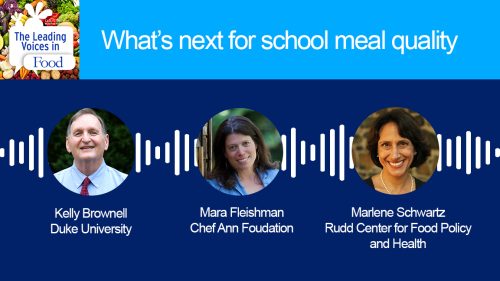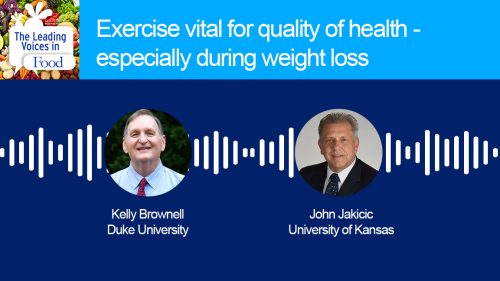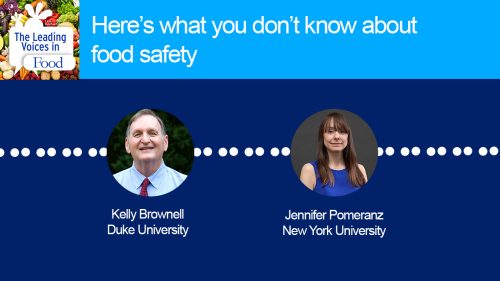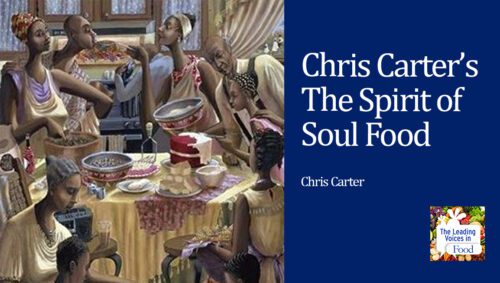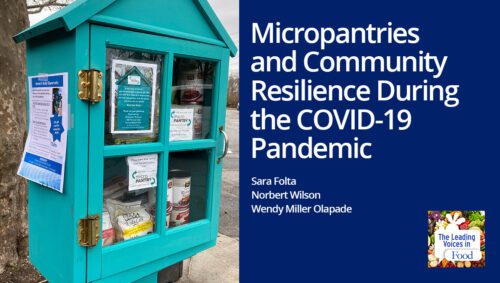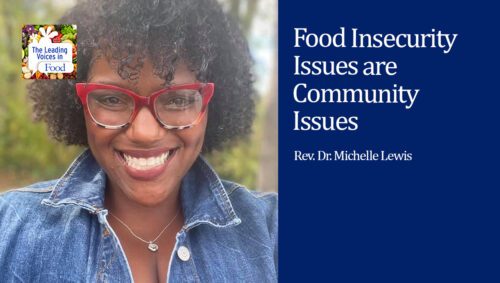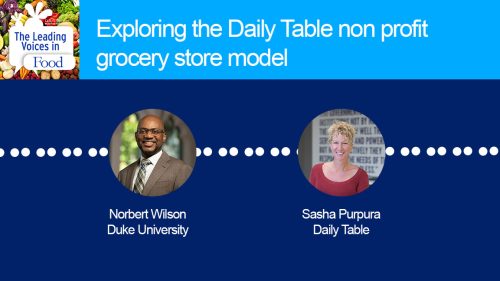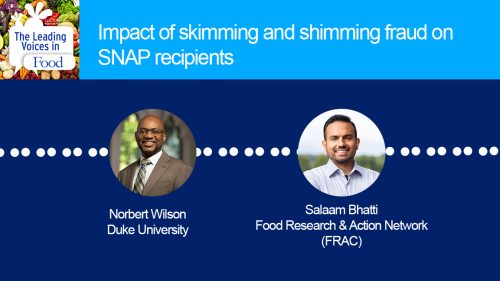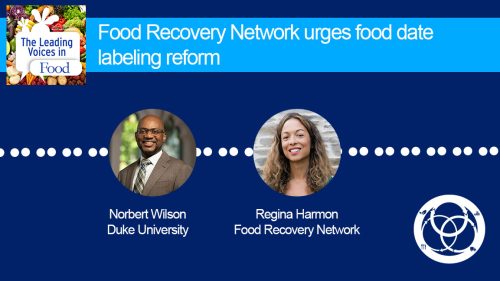The Leading Voices in Food
E20: Darriel Harris on Harnessing Faith to Improve Community Health
Can you make sustainable changes in community or neighborhood health without tackling the issue of food and diet? Why is such work so difficult? What is the role of churches and other faith organizations? Our next guest on The Leading Voices in Food is Reverend Darriel Harris and he works on this problem in a variety of ways.
Subscribe: Apple Podcasts | TuneIN | YouTube Music | SoundCloud | PocketCasts | Radio Public
Tags: Community & Economic Development | Diet & Nutrition | Faith & Food | Food Insecurity |

Darriel Harris is on the cusp of earning his doctorate at Johns Hopkins School of Public Health in the Department of Health, behavior and society, and he has a deep history of engagement with education. He holds a bachelor in electrical engineering from Oregon State, an MBA in organizational management from George Washington University, a graduate certificate in financial management from the University of Maryland, and a master’s degree of divinity at Duke University. He looks at issues from a broad range of perspectives. Right now, he is focused on faith-based health communications, neighborhood-related health factors, social determinants of health and community based participatory research. He previously worked as a missionary in South Sudan, is also a pastor at a church in Baltimore, Maryland, and is a founding member of the Black Church Food Security Network.
Interview Summary
A lot of our listeners might not be familiar with terms like faith-based health communications or social determinants of health. Can you explain?
Okay. So those two things are very different. Faith-based health communication means that you’re trying to do some type of health behavior change, or some type of health education, so that people can become aware of an issue. And you do that in a religious institution. Usually we call that faith-based. It’s done in good ways and in bad ways. Usually when you just use the institution as the gathering place we call that faith-placed. When you institute some aspect of the religion into the messaging itself, then we call that really faith-based–because faith is playing a role and not just as a node where people gather.
Let’s hone in on that before we get to the social determinants of health because there’s some great stuff right there. So you said some people do it well, some people do not so well. Could you give an example from your work and one you’ve seen that you feel is not executed as well?
Sure. So I’m a critic. I’m a critic of the status quo. Essentially the status quo is that some scientists, well meaning, some medical doctor or a public health professional, wants to convey some sort of health messaging to an audience. And so therefore they go to churches or religious bodies because these are natural gathering spaces. But usually once they get there, the language that they use–it’s really scientific language which is probably not most appropriate in that setting. Within a religious setting, there’s a religious language that is used most often within those religious settings. The surrounding environment puts you in a certain mindset and that community has a language. We need to really, really start honing in on language.
Anytime you do education that’s meaningful and that’s not oppressive, it does require some type of dialogue so people are on equal footing. And the way that science has engaged with faith-based institutions historically has been that they come to the faith based institution and they speak science. They lead with science. And then they leave and they are expecting people within the organization to adjust and to embrace their messaging. So I’m a critic of that. I think that there has to be more of an equal footing. And what I’m proposing is more or less a dialogue where the faith institution and the scientific institution are equal partners on equal footing. So instead of the scientists coming into the body and speaking scientific language, the scientist is going to the faith body and saying, faith body, teach me how to speak in your way. And then someone who’s educated and trained to articulate the faith language within that body is going to work with the scientist to come up with the proper messaging.
Could you give us an example of how you’ve been able to do that?
So I got this idea while I was working with Professors Ellen Davis from the Duke Divinity School and Peter Morris. They sent me to South Sudan when I graduated from Divinity school. Ellen Davis is like the premier Old Testament scholar living today. Dr. Peter Morris is used to be a student of Ellen Davis. He was the leading health professional for Wake County and now he runs a nonprofit in Raleigh.
Ellen Davis has been working in South Sudan for years. She invited Peter Morris to come join her. Peter Morris decided to do that and they’ve been going to South Sudan year after year after year. I come along and they invited me to join them as well. I went but they pushed this agenda that said go to South Sudan and try to teach people about health. And when I went to South Sudan everyone wants to hear about the Bible. They didn’t care about health. I mean, it’s not that they didn’t care about it, but that wasn’t what they were most interested in. So I was there trying to teach them about health and they wanted to hear about the Bible. Professor Ellen Davis with her biblical interpretation kind of lens and mindset–she was really pushing for kind of like a merging of the two.
So I did that. And I talked to people about malaria and washing hands with soap through biblical messages. So if we apply that to the American context and we’re saying, okay, if I’m a scientist the way it’s done now, the worst scenario would be the scientist comes into the church and says people need to eat more fruits and vegetables. If you eat more fruits and vegetables, you’ll be healthier. Which is a common message because every doctor says it to most patients every time they go in there.
If the scientist is somewhat savvy and is trying to be sensitive to the religious audience that they’re working with, maybe they’ll give their science-based message and they’ll quote, you know, people who eat more fruits and vegetables have a tendency to live longer. They’re less likely to get this disease and that disease. But then they’ll, they’ll marry that with a verse and they’ll say the body is a temple of God. Or they’ll sing a spiritual him at the end of it. But it’s kind of tacked on, it’s like an addendum really.
So what I’m proposing is to this: if you want to go into that faith institution and you want to teach people about fruits and vegetables, then open up Genesis and talk about how when God created the world. God created vegetation and when God created human beings, male and female, God created them and tells them that fruits and vegetables are to be your meat or the primary ingredient upon what you eat. And so then you can marry in some science. Say, okay, people who do this are live longer, they have healthier lives. But it’s a theological basis for the behavior and not simply a scientific basis for the behavior.
Has your experience been more successful? And also maybe riffing off your experience in south Sudan?
So that’s the test, right? My dissertation is to test the effectiveness of those three modes. Those are the three elements of my dissertation: science only, science only with some type of religious reference tacked onto it, which is the status quo, or what I am proposing, which is a true merging. So results pending, results pending. (laughs) But I can say anecdotally in South Sudan, I will go into villages and I would teach these messages to people about mosquito nets and I would talk about how Mary wrapped little baby Jesus in swaddling cloth. And what was the reason that she did that? That this is protective. The reason that she did that is protective. And then we would say if Mary was in South Sudan where the mosquitoes were killing everyone, would she allow her to son to be bitten by mosquitoes? She would put some type of protective cover over the child and people would say oh, Mary would cover the child. Mary will cover the child.
And so this is how we would teach 10 health lessons. Somebody would go teach the lessons and the people would say, we’ve never heard this before. Now I would go into the health clinic and I would see on the wall chart stuff, mosquito vectors, etc. People are constantly talking about malaria and where malaria comes from. But when we taught it, they say, we’ve never heard this before. Anecdotally, we sent another student after I was there for a year and a half after I came back. Another student went there for a few weeks and he went around and counted the pit latrines in some villages that were there. They had zero pit latrines when I was there. When he came there, there was 100 pit latrines in some of these villages.
So just learning about the science was not enough to leverage behavior change?
It’s not enough. It’s not enough. And behavior change is really, really hard. It’s a hard thing to get someone to change their behavior because changing their opinion is hard. Right? Which is why we see that in the political sphere. But, it’s also in our day-to-day interactions. And so you need every bit of leverage you can get. The biggest thing that they’ll do differently is that they’ll listen. So when when you present it as a faith argument, faith presentation, at the least, they’re open. They’re open to it a little longer before they shut their minds off. So it’s not a panacea in such that if I come and I preached this message, then everyone’s going to follow exactly what I suggest, right? It doesn’t quite work like that. But what we’re trying to do is what essentially what we learn in seminary. We talk about preaching being something that affects the hearing. And so that’s what we’re trying to do in speech in general. And so I’m using theology, using the biblical language, using something that somebody already cares about. It allows him to listen and consider it a little longer. And most likely if you’re using some type of a biblical reference, then there’s something that’s going to come up again with even without effort.
We know food culture is a very strong pull that’s been there for years, but this is another kind of cultural power that could come to be leveraged. So we also talked about this a little while ago, but social determinants of health. I want to come back to that and talk about neighborhood-related health factors, social determinants of health. What are these terms and how does it fit into your work?
Social determinants of health means what things are happening around the individual or group of individuals that leads them to exercise their behavior that they practice. So, in my Baltimore context, we have a thing called food deserts, or healthy food prioritization areas, or the newest term is food apartheid. And the reason why that term is has come to fore is because food availability largely falls along racial lines. And in the environments where healthy food is not available you can’t expect people to make wise decisions around their food when the only thing that they see is bad food. It becomes normal. So when we talk about people eating better, the social determinant of health is what’s available to them. What’s the norm within that community? What are the barriers that they have to go through? And how hard is it to buy or purchase, eat healthy food if they want it to.
How does your involvement with the Black Church Food Security Network address those things? That’s one piece of a larger portfolio of your work, but we would love to hear more about that network and what it’s trying to do.
So the Black Church Food Security Network is trying to do several things. Baltimore has so many problems, it’s really hard to specialize on any one. And so the network is trying to address the food problem. And we use black churches because black churches are in abundance everywhere healthy food is lacking–where healthy food is lacking, there’s an abundance of black churches. The goal is to work with the black churches, partner with the black churches, so that they can be vehicles of change, right? We partnered with churches, qe planted gardens in several churches around Baltimore. We have market days, so it kinda like a farmer’s market, but it’s happening at the natural meeting times of the congregations. We started off with ARK Church in Baltimore city.
They had a Wednesday Bible study–midday Bible study. So we started off selling fresh produce at midday Bible study. And then now we’ve moved on to Pleasant Hope Baptist Church, which is pastored by Reverend Dr. Heber Brown. He’s a great, great friend. And he’s kinda like the lead of the Black Church Food Security Network. So now at his church on Sundays there’s a farmer’s market that is set up at the church. So people come to worship service like they always have. And then after worship service, the market is set up and those who desire–and everyone is encouraged to participate–but those who desire can come in and purchase food that’s available.
You’ve got a lot of different pieces of work. So what solution or opportunity are you most excited about right now?
I’s hard to say. I’m excited. So we now have a farm. It’s called Strength to Love 2 Farm in my church. My church started the farm before I was ever involved in it. But now it’s there. We’re trying to figure out how to mature it and see grow to its fullest potential. That farm is in the middle of a neighborhood called Sandtown. Sandtown was the neighborhood where Freddie Gray was from. He is the young man who died in police custody a few years ago. And in response to his death, there was what we like to call the uprising where CVS was burned and there was violence between police officers and high school children. The National Guard was called in. Children were called thugs by the Mayor, by the president. It was a good time in the city because people were awakening to the issues, but it was a very rough time in the city because there was a lot of destruction. Things happened not the way that we wanted them to happen and the city was characterized in the way that was not honest.
And that is the ground work for this place-based intervention?
Sorry, yes. So you’re asking about what makes me excited? And so the farm is right in the middle of that neighborhood. It’s 1.5 acres. We’re growing food there. We’re employing returning citizens, coming home from incarceration, returning home from incarceration. We’re selling a large amount of that produce to high end farmer’s markets because we’re trying to create employment. But then a portion of that food is also going within the neighborhood. So we’re solving problems. We sell a portion of that food through the Black Church Food Security Network and we sell some of that food at the farmer’s market on Sundays. And it becomes also an educational space. People from all over the city come into one of the areas of the city that frankly is despised. It’s a despised area by many people. Most people are afraid to come in there. They don’t want anything to do with it. But people will come to learn about the farm and the see the farm to witness it. And so it gives everyone who works there a sense of pride, which is great. Which is one of our huge issues that people here are lacking dignity. And so, any type of positive attention helps build that up.
There’s a lot of layers to that project, the dignity, the inclusive economic growth, the food security elements, education. I can see why you’re excited about that one.
It’s a lot of layers. So if you wanted to talk about like what social determinant is most impacting why we have some of these food issues? And I would say it’s the clustering of poverty. And so whenever we’re envisioning putting low income housing or federal housing someplace, they’re envisioning putting it in a place that is already highly stressed. Which doesn’t make any sense, right? So Heber really liked to say, oh, it’s a food desert. But it’s not just the food deserts it’s an employment desert, all these other things. It’s really a life desert. And so people in some of these neighborhoods are dying 20 years younger than the affluent neighborhoods within the same city. We’re talking like two miles away. People living there with a 20-year life expectancy difference. So why did that neighborhood get that way? Why did they put all the people who are enduring the most stress in life all in one place? Even with all these different programs, even the farm, it is not enough to overcome all the issues that are associated with it. And so I believe the real issue is to disperse poverty.



